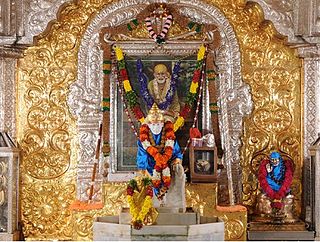
Sai Baba of Shirdi, also known as Shirdi Sai Baba, was an Indian spiritual master and fakir, considered to be a saint, revered by both Hindu and Muslim devotees during and after his lifetime.

Sai Kung District is one of the 18 districts of Hong Kong. The district comprises the southern half of the Sai Kung Peninsula, the Clear Water Bay Peninsula in the New Territories and a strip of land to the east of Kowloon. Areas in the district include Sai Kung Town, Hong Kong UNESCO Global Geopark, Tseung Kwan O and over 70 islands of different sizes. The administrative centre had been located in Sai Kung Town until the Sai Kung District Office was relocated to Tseung Kwan O recently. The district's population is concentrated in Tseung Kwan O, as of 2011. In 2011, the district was the third youngest district, with a median age of 39.3. Known as the "back garden of Hong Kong", Sai Kung has been able to retain its natural scenery. Many traditional customs and cultures are still retained in the rural villages.

Fong Sai-yuk is a semi-fictional Chinese martial artist and folk hero from Zhaoqing City, Guangdong Province of the Qing dynasty. Fong was also associated with Hung Hei-gun and the Five Elders of the Southern Shaolin Monastery. He was a disciple of Shaolin and his martial arts techniques were considered to have contributed to the development of Hung Ga Kuen.

Shirdi is a city and pilgrimage site in the Indian state of Maharashtra. Shirdi is home to 19th century Indian satguru Sai Baba's samadhi mandir. It is located in the Rahata taluka of Ahmednagar District. It is accessible via the Ahmednagar–Malegaon State Highway No.10, approximately 83 km (52 mi) from Ahmednagar and 15 km (9.3 mi) from Kopargaon. It is located 185 km (115 mi) east of the Ahmednagar–Manmad road. Shri Saibaba Sansthan Trust is located in Shirdi.

Kau Sai Chau is an island located off the coast of Sai Kung Peninsula, Hong Kong, with an area of 6.70 km2, making it the 6th largest island of Hong Kong. It is under the administration of Sai Kung District.

Tō-ji Temple, also known as Kyō-ō-gokoku-ji is a Shingon Buddhist temple in the Minami-ku ward of Kyoto, Japan.

Parbhani district is one of the eight districts in the Marathawada region of Maharashtra state of India. Parbhani city is the headquarters of this district. Parbhani district is well known for the Marathwada rebellion and religious tourism of Hinduism, Jainism.

Disciples of the 36th Chamber is a 1985 Shaw Brothers Studio Hong Kong martial arts film comedy written, directed and choreographed Lau Kar-leung. It is the third in a loose trilogy of films that began with The 36th Chamber of Shaolin (1978) and was followed by Return to the 36th Chamber (1980). In Disciples, the action is focused on Hsiao Ho, who portrays legendary martial artist Fong Sai-Yuk. Gordon Liu, a constant in the 36th Chamber series, reprises his role from The 36th Chamber of Shaolin as the monk San Te.

Sai Kung Town, or simply Sai Kung, is a town on the Sai Kung Peninsula facing Sai Kung Hoi in the New Territories, Hong Kong. Sai Kung is the central hub of nearby surrounding villages, and, hence the name, may also refer to the areas in its immediate surroundings.

High Island or Leung Shuen Wan Chau is a former island located in the southeast of Sai Kung Peninsula in Hong Kong, within Sai Kung District. Two sets of dams constructed between 1969 and 1979 and crossing the former Kwun Mun Channel (官門海峽), connect the island to the peninsula, thereby forming the High Island Reservoir. Before being connected to the mainland, the island had an area of 8.511 km² (3.29 square miles) and was the 4th largest island of Hong Kong in 1960.
Valasaravakkam is a neighbourhood in the Chennai district of the Indian state of Tamil Nadu and a residential suburb of the city of Chennai. It is located in the Maduravoyal Taluk at a distance of approximately 15 kilometres from the Kilometer Zero stone. Valasaravakkam lies on the Arcot Road, one of Chennai's arterial roads. It is under the Maduravoyal election constituency. In October, 2011 Valasaravakkam Municipality ceased to exist and the area became part of Chennai Corporation as Ward Nos 149 and 152, Southern Region, Corporation of Chennai. As of 2011, the town had a population of 47,378. Famous Sivan temple is in Kesavardhini.

Hinduism in Mexico is a minority religion. There were about 12,601 (0.01%) Hindus in Mexico as of 2020.

The Shirdi Sai Baba movement is the religious movement of the followers and devotees of the 19th- and early 20th-century Indian saint Sai Baba of Shirdi. It has spread from Indian Hindus and Muslims across the world. Sai Baba is worshipped by people of all regions and is called ‘Baba’, meaning father or grandfather, by devotees. He is a spiritual guru known for his divine powers and miracles.
Sai-Dham at Rani, (Rajasthan) is a replica of original Shirdi Sai Baba Temple.
Shivam Road is a major commercial and residential area in Amberpet, Hyderabad, Telangana, India. This area is named after the Shivam Temple which houses a large shiva lingam, with the foundation stone laid by Satya Sai Baba.
The following are the temples located in and around Hyderabad

The shōrō, shurō or kanetsuki-dō is the bell tower of a Buddhist temple in Japan, housing the temple's bonshō (梵鐘). It can also be found at some Shinto shrines which used to function as temples, as for example Nikkō Tōshō-gū. Two main types exist, the older hakamagoshi (袴腰), which has walls, and the more recent fukihanachi (吹放ち) or fukinuki (吹貫・吹抜き), which does not.
Bandlaguda Jagir is a satellite city of Hyderabad and a municipal corporation in Rangareddy district, Telangana, India. It Falls Under Gandipet mandal of Rajendranagar revenue division. It recently upgraded to a municipal corporation.
Shirdi Sai Baba Temple is a Hindu temple located in the neighbourhood of Mylapore in Chennai, India. It is dedicated to the Indian saint Sai Baba of Shirdi.

Sri Naga Sai Mandir is a Hindu temple dedicated to the Indian Spiritual Master Shirdi Sai Baba in Coimbatore in the Indian state of Tamil Nadu.
















